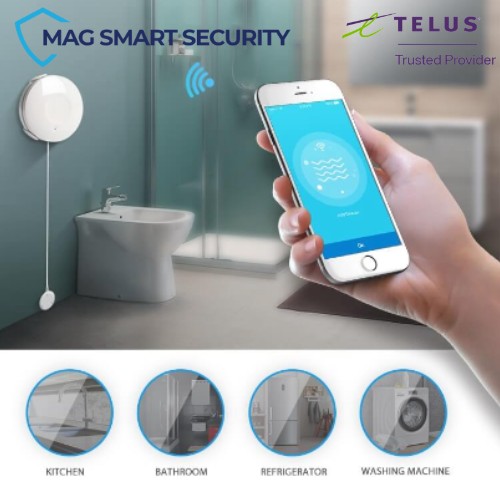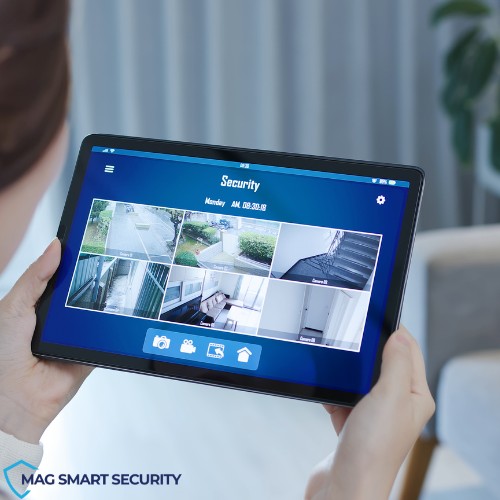The concept of a “smart home” has evolved from a futuristic dream to an everyday reality. With the advent of advanced technology, smart home installation companies now offer different services to transform traditional homes into intelligent, connected spaces.
Let us explore the recommended smart appliances that smart home installation companies offer for residential and commercial use. These devices promise to enhance convenience, efficiency, and security in our daily lives.
Recommended Smart Appliances
Smart home installation companies specialize in integrating cutting-edge technologies into residential and commercial spaces. They offer home automation, security system installation, and smart home devices. These companies are necessary in guiding homeowners and businesses through making their spaces smarter and more efficient.
For Security Services
Include description, uses, benefits, risks, and maintenance when discussing per smart appliance.
Video Doorbell (Exterior)
| Description | An outdoor camera with 1080p HD, HDR wide-angle capabilities, motion-based recording, night vision, and the ability to live stream/record videos. |
| Uses | Enhance surveillance, deter intruders, and monitor outdoor spaces. |
| Benefits | Improved visibility, evidence collection, and remote monitoring. |
| Risks | Privacy concerns, dependency on network stability. |
| Maintenance | Regular cleaning of the lens and firmware updates. |
| Description | A smart lock offering remote lock/unlock capabilities, easy keypad entry, programmable unique codes, and Bluetooth pairing for hands-free entry. |
| Uses | Secure entry points and manage access remotely. |
| Benefits | Convenience, enhanced security, keyless entry. |
| Risks | Technical malfunctions, reliance on connectivity. |
| Maintenance | Battery replacements and regular security checks. |
Smart Control Panel (Interior)
| Description | An HD touch/swipe panel offering access to security and smart home features in one location. |
| Uses | Centralized control, monitoring live video feeds. |
| Benefits | Streamlined control and quick access to information. |
| Risks | Potential vulnerability if not properly secured. |
| Maintenance | Regular software updates and system health checks. |
| Description | Sensors provide open/close notifications, easy installation, and compatibility with smart bulbs/outlets for home automation. |
| Uses | Monitor entry points and automate home functions. |
| Benefits | Enhanced security and automation possibilities. |
| Risks | False alarms, technical malfunctions. |
| Maintenance | Regular checks for proper alignment and battery replacements. |
| Description | A smart smoke detector with carbon monoxide detection, 24/7 professional monitoring, emergency response alerts, and LED low battery indicators. |
| Uses | Early detection of fires and gas leaks. |
| Benefits | Life-saving alerts and professional monitoring. |
| Risks | False alarms, dependency on battery life. |
| Maintenance | Regular testing, battery replacements, and professional servicing. |
For Cameras
Outdoor Camera (Exterior)
| Description | An outdoor camera boasting 1080p HD resolution, HDR wide-angle capabilities, motion-based recording, night vision, and the ability to live stream/record video. Paired with smart light bulbs for enhanced security. |
| Uses | Monitor outdoor spaces, deter intruders, and enhance overall security. |
| Benefits | Clear video footage, motion-triggered recording, and extended surveillance. |
| Risks | Privacy concerns, dependency on network stability. |
| Maintenance | Regular lens cleaning and firmware updates. |
Pairing with Smart Light Bulbs
| Description | Integration with smart light bulbs for synchronized security measures. |
| Uses | Enhanced visibility, simultaneous lighting, and video recording. |
| Benefits | Improved security, increased deterrent effect. |
| Risks | Technical glitches and dependency on the smart lighting system. |
| Maintenance | Regular checks for connectivity and firmware updates. |
Indoor Camera (Interior)
| Description | An indoor camera equipped with night vision, two-way audio, two-way conversation initiation, video analytics for customization, full 1080p HD resolution, and a wide-angle lens. Features smart notifications and the ability to livestream/record video, accompanied by an LED status light. |
| Uses | Monitor indoor spaces, facilitate two-way communication, and customize video monitoring. |
| Benefits | Crystal-clear video, enhanced communication, tailored video analytics. |
| Risks | Privacy concerns, potential misuse of two-way audio. |
| Maintenance | Regular lens cleaning and firmware updates. |
Video Analytics and Smart Notifications
| Description | Advanced features such as video analytics for customized monitoring and smart notifications. |
| Uses | Tailor surveillance and receive relevant alerts. |
| Benefits | Reduced false alarms and focused monitoring. |
| Risks | Potential misinterpretation of analytics and reliance on accurate settings. |
| Maintenance | Regular calibration and updates to analytics software. |
LED Status Light
| Description | An LED status light indicates the camera’s operational state. |
| Uses | Visual confirmation of camera status. |
| Benefits | Quick visual check, deterrent effect. |
| Risks | Potential visibility concerns, reliance on indicator accuracy. |
| Maintenance | Regular checks for LED functionality and firmware updates. |
For Home Automation Services
Smart Lightbulb (Exterior)
| Description | A smart lightbulb designed for outdoor use, capable of automation through door sensors, motion-based rules with cameras, and scheduled operation from dusk to dawn. |
| Uses | Enhance outdoor visibility, improve security, and automate lighting based on activity. |
| Benefits | Increased energy efficiency, customized lighting, heightened security. |
| Risks | Technical malfunctions and dependency on sensor accuracy. |
| Maintenance | Regular checks for connectivity and firmware updates. |
Automation with Door Sensors and Cameras
| Description | Integration with door sensors and cameras for advanced automation. |
| Uses | Trigger lighting based on door activity enhances security. |
| Benefits | Targeted automation and synchronized security measures. |
| Risks | False triggers, dependency on sensor accuracy. |
| Maintenance | Regular checks for sensor functionality and firmware updates. |
Water Sensor (Interior)
| Description | A water sensor designed to detect leaks near washers, toilets, sinks, water heaters, and more, providing real-time notifications if water is detected. |
| Uses | Prevent water damage and early leak detection. |
| Benefits | Timely alerts and potential cost savings from preventing water damage. |
| Risks | False alarms, dependency on sensor accuracy. |
| Maintenance | Regular checks for sensor functionality and battery replacements. |
Smart Plugs
| Description | Smart plugs for automating lamps or appliances provide smart control and are ideal for seasonal décor. |
| Uses | Control devices remotely and automate lighting and appliances. |
| Benefits | Energy savings, convenience, enhanced control. |
| Risks | Technical malfunctions and dependency on network stability. |
| Maintenance | Regular checks for connectivity and firmware updates. |
Smart Thermostat
| Description | A smart thermostat allows remote control, notifications of extreme temperature variances, monthly energy reports, and compatibility with voice assistants. |
| Uses | Optimize energy usage and control climate remotely. |
| Benefits | Energy savings, increased comfort, voice-controlled convenience. |
| Risks | Technical malfunctions, dependency on internet connectivity. |
| Maintenance | Regular system checks and firmware updates. |
Are Smart Appliances Right for Your Home?
Integrating smart appliances into your home is significant. So, consider various factors to ensure these innovations align with your lifestyle, preferences, and practical needs. Here’s a breakdown of key aspects to help you determine whether smart appliances are the right fit for your home:
Lifestyle Compatibility
Consider your daily routine and how smart appliances might enhance or streamline tasks. Are you seeking more convenience in managing household chores, or do you value traditional methods? Smart appliances are designed to complement modern lifestyles, providing efficiency and control.
Budget Considerations
Evaluate your budget and the cost associated with implementing smart appliances. While these technologies offer numerous benefits, weighing the initial investment against their long-term advantages is essential. Many users find that the enhanced features and energy savings justify the upfront costs over time.
Energy Efficiency Goals
If you want to reduce environmental impact and lowering energy bills, smart appliances can contribute significantly to these goals. Features like programmable thermostats, energy reports, and optimized usage patterns empower homeowners to make eco-friendly choices effortlessly.
Integration with Existing Systems
Assess how easily smart appliances can integrate into your current home setup. Compatibility with existing devices, connectivity infrastructure, and the ability to work seamlessly with other smart systems can contribute to a more cohesive and enjoyable smart home experience.
Security and Privacy Concerns
Acknowledge any security or privacy concerns you may have regarding integrating smart appliances. Understand the measures in place to safeguard your data and ensure that the benefits of smart technology do not compromise the security and privacy of your home.
Technical Aptitude
Consider your comfort level with managing smart appliances. Many systems are designed to be user-friendly, but always ensure that you and your household members are comfortable navigating and troubleshooting these devices.
Long-Term Value
Reflect on the long-term value that smart appliances bring to your home. From increased property value to ongoing updates and improvements, these devices offer enduring benefits that contribute to your residence’s overall value and appeal.

Partner With A Reliable Smart Home Security Company
Ready to experience the future of living and working? Contact MAG Security, one of the best smart home installation companies today, to explore the possibilities of transforming your space with smart security systems.
Take advantage of a smart home or office’s convenience, efficiency, and security. Elevate your lifestyle—get in touch now.
Frequently Asked Questions
How Do Smart Home Appliances Work?
Smart home appliances use Wi-Fi or other communication protocols to connect directly to a central hub or the internet. Users can control these appliances through dedicated apps on their smartphones or other smart devices.
What Are the Advantages of Using Smart Home Appliances?
Some advantages include increased energy efficiency, convenience through remote control, automation capabilities, integration with other smart devices, and the potential for cost savings in the long run.
Are Smart Home Appliances Secure?
Manufacturers implement security features like encryption and authentication to protect smart home appliances. However, users should also take steps to secure their home networks, use strong passwords, and keep their devices and software updated to minimize security risks.
Do Smart Home Appliances Work With Voice Assistants?
Many smart home appliances are compatible with popular voice assistants like Amazon Alexa, Google Assistant, and Apple’s Siri. This allows users to automate their devices using voice commands.






